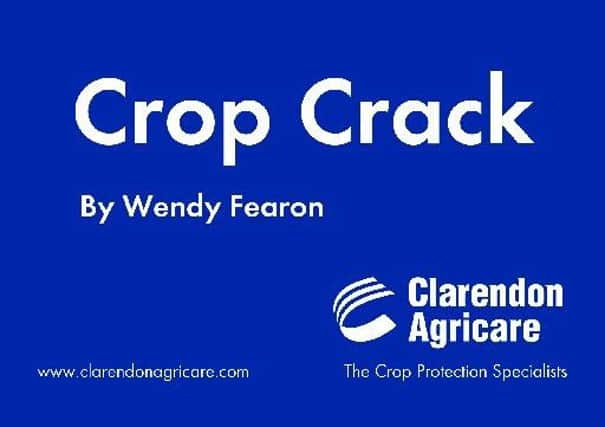Dry weather brings fieldwork up to date


Spring drilling is now complete and early drilled crops are emerged and growing well. Lack of soil moisture may become an issue, delaying crop emergence in later drilled fields and delaying weed emergence in the earlier fields.
The dry conditions have hampered sealing of many of our vegetable and potato crops. Co Armagh is in full bloom this weekend and tight spray programmes are critical at this time as scab pressure remains high. It is also important to check for mildew and red spider mite at this time.
Advertisement
Hide AdAdvertisement
Hide AdWinter cereal crops are moving rapidly through their growth stages. As a result of the predominantly dry April and better timed spray treatments than many other years, the wet weather diseases, Septoria and Rhyncho remain lower down the plants, well controlled by the T1 application. Dry weather diseases have been more problematic this year, with Net Blotch, mildew and Ramularia appearing in barley and Yellow Rust and Mildew in wheat.
As awns appear in barley and the flag leaf emerges in wheat, the T2 fungicide timing is fast approaching.
Properly protecting the top three leaves and ear at T2 is critical to yield and profit - foliar disease not controlled effectively at this time will hasten the senescence of these leaves during grain filling, and therefore impact adversely on yield and grain quality. This treatment will extend canopy duration therefore increasing the amount of starch produced for grain filling, and increase grain storage capacity leading to higher thousand grain weight (TGW).
Winter Barley
Correct timing of fungicide applications is critical to optimizing activity and product performance. The T2 treatment should be applied from flag leaf sheath extending, through booting to first awns visible, GS41-49. As well as protecting against Rhyncho, this treatment also needs to protect the plant against Ramularia, Brown Rust and Net Blotch through to the end of the season. Awns contribute equally to yield and it is important to keep them free of disease also.
Advertisement
Hide AdAdvertisement
Hide AdFor crops with good yield potential, the inclusion of SHDI along with triazole and multi-site is very much the norm now, ensuring persistency of the treatment right through to ripening. Best options include AYLORA or CONCORDE mixed with MOBIUS/MANTRA/RUBRIC and the multisite chlorothalonil. Good practice would be to use a different SHDI/triazole combination now to that already used at T1. Where a crop with lower yield potential discourages their use, non SDHI chemistry using triazole/strobilurin/morpholine mixes are also robust options eg OPUS-TEAM, MANTRA or MOBIUS. As a result of its resistance to triazoles and the SDHIs increasing, chlorothalonil should now be considered an essential component of all T2 treatments helping the control of Ramularia.
Winter Wheat
In wheat the T2 should be applied during the emergence of the flag leaf, GS37-39. Of all treatments, this flag leaf timing is the most responsive to yield and therefore products used should reflect this. Against a background of Septoria being present in all crops and significantly reduced kickback activity from core chemistry, the T2 timing is critical to ensure effective protectant performance.
Managing resistance and maintaining reliable disease control now means using a range of different actives over the course of the growing season
It is good practise to use different actives from within the same chemical group at the different spray timings. Where possible, use a different SDHI at T2 to that used at T1, and likewise use different triazoles over the course of the season to give the widest possible activity across the different strains of fungi of all diseases.
Advertisement
Hide AdAdvertisement
Hide AdBecause it provides multiple modes of activity acting preventatively on Septoria and has no known resistant strains to the disease, chlorothalonil should also be included in all well timed T2 programmes to provide some control of those strains now showing resistance to triazoles and even SDHIs. In crops susceptible to lodging a plant growth regulator should be applied at this time.
Spot Treatment
Spot treatment is a very cost effective way of controlling low to medium levels of problem weeds in grassland field margins and around non-crop areas. Low levels of weeds whilst not economically important need to be controlled to prevent those setting seed and returning large numbers of seed to the surrounding fields hence producing a problem for the future.
Spot treatment is also the best way to control woody weeds such as bramble and gorse. Gorse is best sprayed late June or early July when the flowering has finished and the new vegetative growth is present. Very strong Gorse is better cut or stubbed out and then spray the regrowth the following season.
Cow parsley is becoming an increasing problem weed it will grow in sunny to semi-shaded locations in fields and at the edges of hedgerows and woodland. It is a particularly common sight by the roadside. It is sufficiently common and fast-growing to be considered a nuisance weed.
Advertisement
Hide AdAdvertisement
Hide AdCow parsley’s ability to grow rapidly through rhizomes and to produce large quantities of seeds in a single growing season has made it an invasive species in many areas of the province. GRAZON PRO will give very good control of cow parsley.